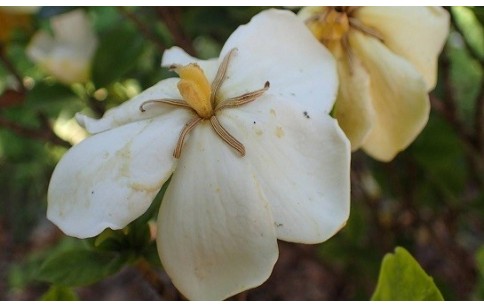- Code : #0233 S 10 mg
- Formula : C₁₅H₂₂O₁₀
- CAS : 2415-24-9
Gardenia jasminoides
Gardenia jasminoides, « Gardenia » both in English and French, belongs to the Rubiaceae botanical family.
Native to tropical and sub-tropical regions of eastern Asia, it grows in many temperate areas. It is a 0.3 to 3 m tall shrub, mostly cultivated for its fragrant flowers but that was also commonly used as a natural yellow dye.
Its fruit is a popular traditional Chinese medicine. It has various biological activities, such as antidiabetic, anti-inflammatory, anti-depression and antioxidant. It improves the quality of sleep. It is used in the treatment of an array of illnesses including jaundice, headaches, fever, inflammation, hepatic disorders, and hypertension.
The fruit main constituents are iridoids, iridoid glucosides, triterpenoids, organic acids and volatile compounds. Geniposide, genipin, gardenoside, catalpol (iridoids) and crocin are its major bioactive compounds.

- Code : #4991 S 50 mg
- Formula : C₁₆H₁₈O₉
- CAS : 327-97-9
- Code : #1362 S 50 mg
- Formula : C₁₅H₁₀O₄
- CAS : 480-40-0
- Code : #0220 S 10 mg
- Formula : C₁₁H₁₄O₅
- CAS : 6902-77-8
- Code : #0221 S 20 mg
- Formula : C₁₇H₂₄O₁₀
- CAS : 24512-63-8
- Code : #1053 S 10 mg
- Formula : C₂₇H₃₀O₁₅
- CAS : 17650-84-9
- Code : #1135 S 20 mg
- Formula : C₁₅H₁₀O₇,2H₂O
- CAS : 6151-25-3
- Code : #0762 A 1 g
- Formula : C₇H₁₂O₆
- CAS : 77-95-2
- Code : #1139 S 50 mg
- Formula : C₂₇H₃₀O₁₆
- CAS : 153-18-4
- Code : #0037 S 20 mg
- Formula : C₃₀H₄₈O₃
- CAS : 77-52-1











